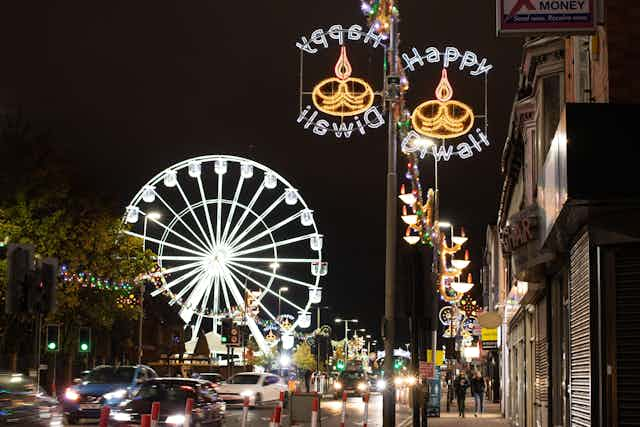The commercial potential of Diwali is capturing the attention of the high street. Big brand retailers are cashing in by adapting existing products to promote sales of Diwali-themed goods. But little, if any, mention is being made of the festival’s religious nature, and that’s a problem.
There might be no single narrative story about Diwali, which falls on October 24 in 2022, but there is a shared meaning. This most widely celebrated festival in the Hindu calendar represents the victory of light over darkness, of good over evil.
Many Hindus associate Diwali with Lakshmi, the goddess of wealth and prosperity. Lakshmi puja (with puja being the act or ritual of worship used) is one of the rituals which marks the start of the new year. People prepare for the arrival of the goddess by cleaning their homes and donning new clothes. They gather together with family, light diyas (small oil lamps made from clay), exchange gifts, eat Indian sweets and have firework displays.

Businesses, of course, are geared towards grabbing attention. Marketing departments exist precisely to boost sales. And the sharing of minority cultures through food, dress, and music does contribute to consumer tastes diversifying. However, my research suggests that using symbols and motifs without sufficient contextualisation runs the risk of cultural appropriation.
In addition, it does not necessarily tackle deeper socio-economic issues – from inequality to structural racism – and can exacerbate them.
Cashing in on religious festivals
Diwali is important economically, both within both the Indian subcontinent and Hindu diaspora communities. In the UK, retailers from South Asian backgrounds who work in the food, fashion and accessories industries, as well as the corner shop owners who stock fireworks, see increased trade in the run up to the festival.
High streets in predominantly South Asian communities, including Belgrave Road in Leicester, transform into a visual spectacle. Shops are decked with colourful lights. People crowd in to buy Indian sweets including barfi, gulab jamun and jalebi. Restaurants are packed with festival goers eating out.

Retailers more broadly are increasingly looking to capitalise on this commercial potential. Sometimes existing products appear to simply be repackaged. Jo Malone foregrounds its fragranced candles and other products for the Diwali market by decorating giftboxes with rangoli motifs (elaborate designs made of coloured rice, sand and flower petals).
Other retailers bring out Diwali-themed, limited-edition product ranges. In the cosmetics sphere, in 2022, these have included MAC’s Diwali Light Festival collection and Bobby Brown’s Aarti P. Diwali Edit 2022 makeup range, a collaboration with the multi-award winning British hair and makeup artist of South Asian descent.
Ikea, meanwhile, creates standalone, seasonal collections, inspired by the festival. A spokesperson for Ikea said the 2022 collection was “inspired by Indian arts and crafts, originally designed for Indian autumn festivities.”
What these various campaigns have in common are similar marketing strategies that home in on the bright colours of the fireworks and the spirit of togetherness Diwali fosters. Commercial collaborations are presented as commitments to principles of inclusivity and diversity, both vital for global organisations.
The absence of religious context
There is something genuinely appealing about seeing the festivals and traditions of minority religions explored by retailers in creative and innovative ways. High street retailers have seized on the fun and celebratory aspects of this festival, the dressing up, the sharing of food, the illuminations.
But there is not much mention of the religious context of the festival. Diwali is described as a “celebration”. MAC describes it as a “joyous holiday”. Hinduism or Hindus are not prominently mentioned.
Ikea, similarly, makes no mention of the religious aspect of Diwali and the company’s spokesperson acknowledged as much. They said that “while we haven’t called out Hinduism specifically in our advertising, we hope the range will appeal to many Ikea customers.”
Soapmaker Lush, by contrast, does explicitly reference the religious roots of the festivals to which it seeks to cater. For its Eid gift range, the website describes the religious holiday Eid Al Adha as being “celebrated by Muslims worldwide”. While the company did not explicitly mention Hindus and Hinduism in its advertising around Diwali products, a spokesperson said the decision was taken in concert with a working group made up of staff members who celebrate the festival “in recognition that other religions, as well as Hinduism” do so.
Cultural appropriation occurs when the culture of minority groups falls into the hands of the majority and dominant culture and becomes used inappropriately and/or without consideration of the views and feelings of the minority culture. The parading of cultural goods by their surface qualities can be seen, in this context, as distorting the deeper symbolism of Diwali. It can also be seen as commercially exploitative.
Since the 1960s, identity politics scholarship has focused on the experience of minority groups and the alliances they have formed to defend their interests. Examples include the civil rights movement, the feminist movement and gay liberation. The way in which these minority identities are politicised means that minority religious identities also become political. In avoiding mention of the religion, retailers focus only on the commercial aspects of the festival, the surface qualities of the outward and social rituals of celebration.
If retailers want to engage with the traditions of minority religions, they need to do this authentically and wholeheartedly rather than skirt around the religious core of these festivals. Partnering with members from these religions is an important step in the right direction.
However, this needs to be underpinned by a commitment to explicitly identify the religion and the contextual narratives of the festival rather than watering it down to the lowest common denominator of aspects, like joy and celebration, that are found in pretty much all festivals.
The retailers named in this piece were approached for comment.

